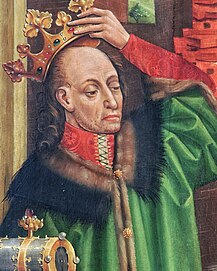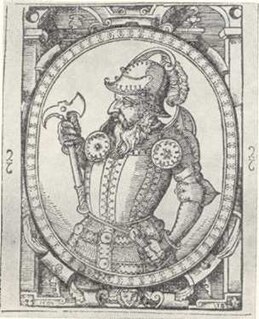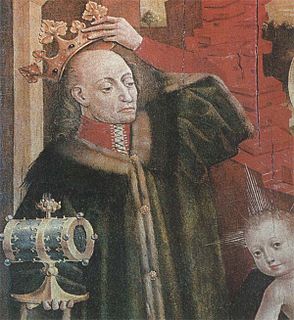
Jogaila, later Władysław II Jagiełło was the Grand Duke of Lithuania (1377–1434) and then the King of Poland (1386–1434), first alongside his wife Jadwiga until 1399, and then sole King of Poland. He ruled in Lithuania from 1377. Born a pagan, in 1386 he converted to Catholicism and was baptized as Władysław in Kraków, married the young Queen Jadwiga, and was crowned King of Poland as Władysław II Jagiełło. In 1387 he converted Lithuania to Christianity. His own reign in Poland started in 1399, upon the death of Queen Jadwiga, and lasted a further thirty-five years and laid the foundation for the centuries-long Polish–Lithuanian union. He was a member of the Jagiellonian dynasty in Poland that bears his name and was previously also known as the Gediminid dynasty in the Grand Duchy of Lithuania. The dynasty ruled both states until 1572, and became one of the most influential dynasties in late medieval and early modern Central and Eastern Europe. During his reign, the Polish-Lithuanian state was the largest state in the Christian world.

Vytautas, also known as Vytautas the Great from the 15th century onwards, was a ruler of the Grand Duchy of Lithuania, which chiefly encompassed the Lithuanians and Ruthenians. He was also the Prince of Hrodna (1370–1382), Prince of Lutsk (1387–1389), and the postulated king of the Hussites.

Švitrigaila was the Grand Duke of Lithuania from 1430 to 1432. He spent most of his life in largely unsuccessful dynastic struggles against his cousins Vytautas and Sigismund Kęstutaitis.

Skirgaila was a regent of the Grand Duchy of Lithuania for his brother Jogaila from 1386 to 1392. He was the son of Algirdas, Grand Duke of Lithuania, and his second wife Uliana of Tver.

The Treaty of Melno or Treaty of Lake Melno was a peace treaty ending the Gollub War. It was signed on 27 September 1422, between the Teutonic Knights and an alliance of the Kingdom of Poland and the Grand Duchy of Lithuania at Lake Melno, east of Graudenz (Grudziądz). The treaty resolved territorial disputes between the Knights and Lithuania regarding Samogitia, which had dragged on since 1382, and determined the Prussian–Lithuanian border, which afterwards remained unchanged for about 500 years. A portion of the original border partially survives as the border between the Republic of Lithuania and Kaliningrad Oblast, Russia, making it one of the most stable borders in Europe.
The Treaty of Königsberg was signed in Königsberg(Królewiec) on May 26, 1390 during the Lithuanian Civil War (1389–1392) between Samogitian nobles and representatives of the Teutonic Knights. The 31-member or 30-member delegation from seven Samogitian regions arrived to Königsberg around the pentecost. They promised their loyalty to "their king" Vytautas and guaranteed trade freedom for the Knights in Samogitia. The Knights gifted the nobles with food and clothes.

The Lithuanian Civil War of 1432–1438 was a conflict over the succession to the throne of the Grand Duchy of Lithuania, after Vytautas the Great died in 1430 without leaving an heir. The war was fought on the one side by Švitrigaila, allied with the Teutonic Knights, and on the other by Sigismund Kęstutaitis, backed by the Kingdom of Poland. The war threatened to sever the Union of Krewo, the personal union between Poland and Lithuania. Švitrigaila's alliance with the Grand Master of the Teutonic Order, Paul von Rusdorf, launched the Polish–Teutonic War (1431–1435) but failed to secure victory for Švitrigaila.

The Ostrów or Astrava Agreement was a treaty between Jogaila, King of Poland and Grand Duke of Lithuania, and his cousin Vytautas the Great, signed on 4 August 1392. The treaty ended the destructive Lithuanian Civil War, launched in 1389 by Vytautas who hoped to gain political power, and concluded the power struggle between the two cousins that erupted in 1380 after Jogaila secretly signed the Treaty of Dovydiškės with the Teutonic Knights. The Ostrów Agreement did not stop attacks from the Teutonic Knights and the territorial dispute over Samogitia continued up to 1422. According to the treaty, Vytautas became the ruler of Lithuania, but he also acknowledged Jogaila's rights to Lithuania. The details of the Polish–Lithuanian relationship were clarified in several later treaties, including the Union of Vilnius and Radom in 1401 and Union of Horodło in 1413.

Andrei of Polotsk was the eldest son of Algirdas, Grand Duke of Lithuania, and his first wife Maria of Vitebsk. He was Duke of Pskov and Polotsk (1342–1387). As the eldest son of the Grand Duke, Andrei claimed his right to the throne after his father's death in 1377. Algirdas left Jogaila, his eldest son with his second wife Uliana of Tver, as the rightful heir. Andrei's rivalry with Jogaila, Grand Duke of Lithuania and later King of Poland, eventually led to his demise.

Treaty of Salynas was a peace treaty signed on 12 October 1398 by the Grand Duke of Lithuania Vytautas the Great and the Grand Master of the Teutonic Knights Konrad von Jungingen. It was signed on an islet of the Neman River, probably between Kulautuva and the mouth of the Nevėžis River. It was the third time, after the Treaty of Königsberg (1384) and Treaty of Lyck (1390), that Vytautas promised Samogitia to the Knights. The territory was important to the Knights as it physically separated the Teutonic Knights in Prussia from its branch in Livonia. It was the first time that the Knights and Vytautas attempted to enforce the cession of Samogitia. However, it did not solve the territorial disputes over Samogitia and they dragged on until the Treaty of Melno in 1422.

The Lithuanian Civil War of 1389–92 was the second civil conflict between Jogaila, King of Poland and Grand Duke of Lithuania, and his cousin Vytautas. At issue was control of the Grand Duchy of Lithuania, then the largest state in Europe. Jogaila had been crowned King of Poland in 1386; he installed his brother Skirgaila as ruler of Lithuania. Skirgaila proved unpopular and Vytautas attempted to depose him. When his first attempt to take the capital city of Vilnius failed, Vytautas forged an alliance with the Teutonic Knights, their common enemy – just as both cousins had done during the Lithuanian Civil War between 1381 and 1384. Vytautas and the Knights unsuccessfully besieged Vilnius in 1390. Over the next two years it became clear that neither side could achieve a quick victory, and Jogaila proposed a compromise: Vytautas would become Grand Duke and Jogaila would remain Superior Duke. This proposal was formalized in the Ostrów Agreement of 1392, and Vytautas turned against the Knights. He went on to reign as Grand Duke of Lithuania for 38 years, and the cousins remained at peace.
Vygantas was Duke of Kernavė. He was one of the sons of Algirdas, Grand Duke of Lithuania (1345–1377), and his second wife Uliana Alexandrovna of Tver.
The Treaty of Dubysa or Treaty of Dubissa consisted of three legal acts formulated on 31 October 1382 between Jogaila, Grand Duke of Lithuania, with his brother Skirgaila and Konrad von Wallenrode, Marshal of the Teutonic Order. During the Lithuanian Civil War (1381–84), Teutonic Order helped Jogaila and Skirgaila to defeat their uncle Kęstutis and his son Vytautas. Trying to realize promises given by Jogaila during the war, Teutonic Order organized the negotiations for the treaty. The acts were signed after six days of negotiations on an island in the mouth of the Dubysa River. The treaty was never ratified and never came into effect. The civil war resumed in summer 1383.
Karigaila was a son of Algirdas, Grand Duke of Lithuania, and his second wife Uliana of Tver. He became the ruler of Mstsislaw after he captured it from the Principality of Smolensk. He is sometimes mistaken for his brother Constantine, who was the founder of the House of Czartoryski.
The Treaty of Königsberg was signed in Königsberg (Królewiec) on 30 January 1384, during the Lithuanian Civil War (1381–1384) between Vytautas the Great and representatives of the Teutonic Knights. Vytautas waged a civil against his cousin Jogaila, Grand Duke of Lithuania and future King of Poland, and allied himself with the Teutonic Knights. In order to secure Teutonic support in the civil war, Vytautas signed the treaty and granted Samogitia up to the Nevėžis River and Kaunas to the Knights. In 1382 Jogaila promised the Knights Samogitia only up to the Dubysa River, but never ratified the Treaty of Dubysa. Samogitia was important for the Knights as this territory physically separated them from uniting with the Livonian order in the north. Vytautas also promised to become Order's vassal. In February several Samogitian regions acknowledged their support to Vytautas and the Knights.
The Treaty of Lyck was a treaty between Vytautas the Great, future Grand Duke of Lithuania, and the Teutonic Knights, represented by Marquard von Salzbach, komtur Arnold von Bürglen, and Thomas, son of Lithuanian duke Survila. It was signed on 19 January 1390 in Lyck, State of the Teutonic Order,. Vytautas, in exchange for a military alliance against his cousin Jogaila during the Lithuanian Civil War (1389–1392), agreed to cede Samogitia up to the Nevėžis River and become the Order's vassal. In essence Vytautas confirmed the Treaty of Königsberg (1384) that he had signed with the Knights during the Lithuanian Civil War (1381–1384). Once betrayed, the Knights now asked for hostages as a guarantee of Vytautas' loyalty. The Order demanded as hostages his two brothers Sigismund and Tautvilas, wife Anna, daughter Sophia, sister Rymgajla, brother-in-law Ivan Olshanski, and a number of other nobles.

Samogitian uprisings refer to two uprisings by the Samogitians against the Teutonic Knights in 1401–1404 and 1409. Samogitia was granted to the Teutonic Knights by Vytautas the Great, Grand Duke of Lithuania, several times in order to enlist Knights' support for his other military affairs. The local population resisted Teutonic rule and asked Vytautas to protect them. The first uprising was unsuccessful and Vytautas had to reconfirm his previous promises to transfer Samogitia in the Peace of Raciąż. The second uprising provoked the Knights to declare war on Poland. Hostilities escalated and resulted in the Battle of Grunwald (1410), one of the biggest battles of medieval Europe. The Knights were soundly defeated by the joint Polish–Lithuanian forces, but Vytautas and Jogaila, King of Poland, were unable to capitalize on their victory. Conflicts regarding Samogitia, both diplomatic and military, dragged until the Treaty of Melno (1422).


























